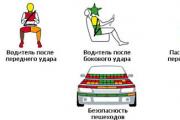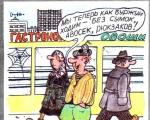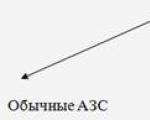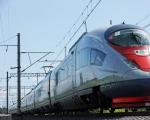Cartel. Cartels are from Germany. A cartel is an association in which the participants of this association do not lose either industrial or commercial independence. The association occurs for (the purpose of the cartel):
ü Establishing a single price for products.
ü Uniform conditions for hiring workers are negotiated.
ü Establish production quotas
ü Agree on the division of sales markets.
Syndicate. Syndicate members lose their commercial independence. The production remains. All products manufactured by syndicate members are sold through syndicate offices. Often, syndicate offices buy raw materials for syndicate members if they can be bought at discounted prices. The birthplace of syndicates is France, and until 1917 - Russia.
Trust is Joint-Stock Company. Participants lose both commercial and industrial independence. It is formed on the basis of the merger of several capitals (different owners) through the issuance of securities (shares and bonds), and these securities are distributed not only between the founders, but can also be freely sold on the stock market or other institutions. This also attracts the capital of the general population.
AO benefits:
All the affairs of the joint-stock company are solved with the help of founding meetings. All issues are resolved by voting. Decisive word owned by the holder of a controlling stake (either 51% of the shares or 50% + 1 share). In practice, it is enough to have from 15% of the shares.
A share is a security that gives its owner the opportunity, or the right, to receive certain income on it, or on it. The income that the owner of the shares receives is called dividends or dividends.
A bond is a security that gives you the opportunity to earn interest in the form of a percentage. The owner of the bond is the creditor.
Bond interest is paid first. Shares pay dividends last.
The birthplace of the trust is the USA.
Concern. Homeland - Japan.
It brings together enterprises from various industries, trade, transport, services, and financial institutions.
The reason for the emergence of the concern is inter-industry competition.
The employees of the concern centrally perform the functions of management, supply, sale of goods, long-term planning, scientific and technical policy, and much more. As a rule, industrial enterprises have independence.
A concern is formed on the basis of the so-called. system of participation, and is a pyramid, the links of which represent different enterprises.
All enterprises are interconnected, the so-called. a single technological chain.
In the 60s of the twentieth century, such associations began to appear in the United States that began to be called conglomerates. It was thought to be the fifth form of amalgamation, but most economists consider it to be a type of concern.
Arise on the basis of capital diversification. The conglomerate is less stable than the concern, because the conglomerate includes enterprises that do not have a single technological chain. Quickly arise, but also quickly disintegrate.
The main organizational forms of economic monopolies are as follows. Cartel- this is an association of several enterprises of the same sphere of production, the participants of which retain ownership of the means of production and the product produced, industrial and commercial independence, and agree only on the share of each in the total production volume, prices, markets.
Syndicate- this is an association of a number of enterprises in one industry, the participants of which retain ownership of the means of production, but lose ownership of the product produced, which means they lose their commercial independence. In syndicates, the sale of goods is carried out by a common sales office.
Trust- this is an association of a number of enterprises in one or more industries, the participants of which lose their ownership of the means of production and the product produced, i.e., industrial and commercial independence. They combine production, marketing, finance, management, and for the amount of invested capital, the former owners of individual enterprises receive trust shares, which give them the right to take part in management and appropriate a corresponding part of the trust's profit. Nowadays, cartels, syndicates, trusts have lost their significance and in their pure form almost never meet.
In modern conditions, on the basis of the diversification of capital, new forms of monopolies are being created - a diversified concern, a conglomerate, a consortium.
Diversified concern- this is an association of dozens, even hundreds of enterprises of various industries, transport, trade, whose participants lose ownership of the means of production and the product produced, and the main company exercises financial control over other participants in the association.
Conglomerate is a huge industrial complex in which, under a single financial control, companies operating in different, technologically unrelated areas are concentrated. As a rule, conglomerates are owned by one firm and produce heterogeneous non-competitive goods at one or more stages of production or operate in market segments that do not intersect. At the same time, enterprises have broad autonomy of economic activity, their management is decentralized.
Consortium is created on the basis of temporary agreements between several banks and industrial corporations for joint large-scale financial transactions or the implementation of industrial projects (placement of large loans, construction of sea canals, ports, pipelines, etc.). After the expiration general works the consortium breaks up. The characteristic features of the modern market are the unification, interweaving, interpenetration of various organizational forms of monopolies, which indicates the further development, deepening of the processes of monopolization of the modern economy.
In order to maintain such an advantageous position in the market, monopolistic associations decisively crack down on competitors by economic and other methods. Let's describe some of these methods.
1. Economic boycott- partial or complete rejection of economic ties with outsiders (enterprises that are not part of a monopolistic association). Monopolies offer buyers dependent on them not to purchase goods from other firms, as they are supposedly of poorer quality.
2. Dumping- the deliberate sale of goods at bargain prices in order to ruin a competitor.
3. Limiting the sale of goods to independent (independent of monopolies) firms (for example, reducing the supply of oil to refineries).
4. Price Maneuvering: The monopoly raises the prices of products sold to small proprietors and at the same time applies secret discounts and concessions in this regard to large buyers.
5. Use of financial means to fight competitors (for example, speculation in securities on the stock exchange).
6. Destruction of competitors with the help of legal and illegal means with the aim of their "absorption" and "attachment" to the monopoly. The latter use a wide arsenal of cruel tricks: they counterfeit competitors' products, violate patents, copy trademarks and brand names, and deceive consumers. Many firms use “industrial espionage” against their market opponents (secretly find out production secrets using electronic means, services of “defectors” from competitors' enterprises, etc.). Some monopolies do not disdain criminal methods, including arson, terrorist attacks and contract killings.
Introduction
1. The main types of business associations
1 Cartel
1.2 Syndicate
1.3 Concern
1.4 Holding
2. Associations of participants of the Russian tourist market
Conclusion
List of used literature and sources
INTRODUCTION
Course project on the topic "Types of associations of firms: cartel, syndicate, trust, concern, holding." contains 22 pages, content, introduction, 2 chapters, conclusion and list of references and sources.
In this course project definitions of such concepts as: "cartel", "syndicate", "trust", "holding" and others are given.
The purpose of writing a course project is to study the types of associations of tourist enterprises in the global Russian market.
The goal defined a number of tasks:
)consider the types of business combinations; )to analyze the state of tourism associations in Russia today. The practical significance of this project is quite large, since associations in tourism are relevant today. Russia has already been affected by integration processes, in particular, in the area of unification of hotel and tourism organizations. In the Russian tourist industry, there is a concentration of capital, corporate structures appear, into which financial capital seeking income flows.
1. MAIN TYPES OF ENTERPRISE ASSOCIATIONS
Today, the word "globalization" is constantly heard from TV speakers, does not leave the pages of printed publications.
In accordance with world forecasts in the first half of the XXI century. 300-600 transnational corporations (TNCs) will remain in the world economy, which will account for up to 75% of the gross world product. More than 1/3 of international companies will concentrate control over the service sector, including tourism.
Increasing the efficiency of the Russian economy is impossible without Russia's integration into the world economy. Foreign investments, which are needed today by many sectors of the Russian economy, including tourism, are largely associated with TNCs. And in this regard, the creation of a Russian TNC in the field of tourism would be quite justified.
World tourism today is controlled by such global corporations as Carison Companies and American Express (USA), Japan Travel Burea (Japan), Preussag, C&N Touristik and Rewe (Germany), Airtours and First Choice (UK), Accor (France) and Groupe Kuoni (Switzerland). They own large sectors of the tourist market. For example, the top five tour operators control 90% of the tourist market in the UK, 88% in the Scandinavian countries, 83% in Austria, 80% in Belgium, 76% in Germany, 70% in the Netherlands, and 58% in France.
Although the Russian tourism business has not yet matured to the formation of large corporations, it has already been affected by integration processes, in particular, in the area of merging hotel and tourism organizations.
The behavior of enterprises in market conditions of management is changing, and this applies to many areas.
Small businesses, typical of commercial entrepreneurship, are very unstable and exist on average for three to five years. This does not mean that they go bankrupt, but most often they modify their activities or try to enter the market in the form of associations.
In modern conditions, when there are rapid changes in the market environment, enterprises face the problem of survival when the market conditions change. To increase the stability of the organization in the unfavorable development of market conditions, business associations are created.
The main advantages of associations are:
) cost reduction;
) higher qualification and specialization of enterprise management;
) more profitable terms procurement of resources, etc.
Associations of legal entities are created in order to coordinate their entrepreneurial activity, as well as to protect common property interests.
Associations of enterprises provide for the existence of different ownership, but the types of associations, depending on the goals and organizational forms, may be different.
According to the legislation, two types of associations of enterprises and organizations can be created and function, these are: voluntary and institutional.
Enterprises have the right to voluntarily combine their scientific, technical, production, commercial and other activities, if this does not go against the antimonopoly legislation.
As well as voluntary associations institutional associations are created and operate, the activities of which begin in a directive order from the ministries (departments) or directly by the Cabinet of Ministers.
In practice, types of associations have developed that differ depending on the goals of the association, the nature of economic relations between their participants, and the degree of independence of the enterprises included in the association. These are cartels, syndicates, pools, trusts, concerns, industrial holdings, financial groups.
1 CARTEL
A cartel is an association, as a rule, of enterprises in the same industry, involving joint commercial activities, i.e. regulation of sales with the help of established quotas, commodity prices, terms of sale.
The cartel is characterized by the presence of the following features:
) the contractual nature of the association;
) preservation of the ownership right of cartel participants to their enterprises and the economic, financial and legal independence ensured by this;
) joint activities for the sale of products, which may extend, albeit to a limited extent, to its production.
cartels ― contractual association of enterprises (firms) of the same industry for the implementation of a joint commercial activities(regulation of the sale of manufactured products). A cartel is a union of several enterprises of the same industry, in which its members retain their ownership of the means and products of production, and the created products themselves are sold on the market, agreeing on a quota - the share of each in the total output, on sales prices, distribution of markets, etc. A kind of cartel association is a syndicate.
2 SYNDICATE
A syndicate is a kind of cartel agreement that involves the sale of the products of its participants through a single marketing body created in the form of a joint-stock company or a company with limited liability. The members of the syndicate, like the cartel, retain their legal and commercial independence, and sometimes their own sales network, which is closely connected with the syndicate sales office or company. The form of a syndicate is most common in industries with mass homogeneous products: mining, metallurgical, chemical.
Syndicates ― the organizational form of the existence of a kind of cartel agreement, which provides for the sale of participants' products through the creation of a joint marketing body or through the marketing network of one of the participants in the association (or for the purchase of raw materials). This form of association of enterprises is typical for industries with mass production of homogeneous products.
3 GROUP
A concern is an association of independent enterprises connected through a system of participation, personal unions, patent and license agreements, financing, and close industrial cooperation.
A concern is usually an association of a production nature, which includes enterprises from different industries, depending on which concerns are in the nature of "vertical" or "horizontal" associations. Vertical association covers enterprises of different industries, the production process of which is interconnected (for example, mining, metallurgical and machine-building). Horizontal associations cover enterprises of different industries that are not related to each other.
The companies merged into the group remain legal entities in the form of joint-stock companies or other economic associations, but have a common management carried out by the parent company (holding).
Concerns ― it is a diversified joint-stock company characterized by unity of power and control. Concerns combine enterprises of various industries, which, as a result of the merger, lose their independence. A concern is one of the most complex forms of association, since it includes enterprises from various industries, banks, transport, trade and carries out joint activities on the basis of voluntary centralization of functions (financial, scientific and technical, production, investment, foreign economic).
Concern - an association of enterprises in which they retain their legal independence, but financial control and certain functions for the supply, production, marketing of enterprises are taken under a single management.
Formally, the enterprises of the concern remain independent, in fact they are financially dependent and controlled by the parent company (the management board of the concern, chairmen).
Members of a group may not simultaneously belong to other groups. Typical modern concerns combine vertical integration of production with diversification, that is, they have a full technological cycle in several industries and sectors of the economy simultaneously.
In Russia, concerns are created on the basis of large state enterprises and associations. Such enterprises, when entering the concern, lose their departmental affiliation.
Concerns are organizational and economic structures. Due to the large-scale concentration of capital, production capacities and the possibility of diversification, they have a certain resistance to market fluctuations, are able to profitably redistribute investments, concentrate them on the most profitable areas.
One of the main functions of industrial concerns was the function of sales. Concerns that have established a well-established sales apparatus have a strong competitive advantage.
In Russia, concerns exist in different forms:
) in the form of state joint-stock industry complexes (Gazprom, Neftekhim);
) in the military-industrial complex as state-cooperative concerns (ANT);
) in the form of "folk", i.e. without participation state structures(BUTEK).
With the development of STP (scientific and technological progress), concerns are turning into scientific and technical centers with research laboratories. In such centers, scientific, experimental and production work is carried out simultaneously.
In Russian, the word concern is most often used in relation to multinational financial and industrial groups in Europe, such as Siemens, ThyssenKrupp, Volkswagen, Drager. Whereas in relation to American entities, the term "group of corporations", "financial group" or FIG is usually used.
The activities of the group may cover one sub-sector or sector of the economy. It may include enterprises of one or more industries. Only a few of the largest concerns cover the entire industry (for example, in Germany, the Siemens concern - the electrical industry). Concerns operate in those sectors of the economy where large-scale and mass production using high technology. Most often, these are ferrous and non-ferrous metallurgy and the steel industry, mechanical engineering and automotive industry, chemical and electrical industries.
From the point of view of the system of participation in capital, two types of concerns can be distinguished:
) a coordination group consisting of sister companies, i.e. created in such a way that the individual companies included in it make a mutual exchange of shares. Thus, all members of the concern have a mutual influence on the policy pursued by the concern, and at the same time it remains under a single leadership.
A subordination concern is created, as a rule, to combine production along the technological chain, and a coordination concern is created for the purpose of integration financial activities or scientific and technological policy, coordinated production development of companies, personnel policy, etc. The concern of coordination, including sometimes loosely connected technological enterprises, in its essence becomes close to such a form of integration of companies as a conglomerate.
Concerns with foreign subsidiaries are international concerns. Moreover, the investments of international concerns can be both transnational and transcontinental.
Large concerns unite from 10 to 100 or more companies, including manufacturing, research, financial, marketing and other firms.
For example, General Motors unites 126 factories in the USA, 13 in Canada, production and sales divisions in 36 countries of the world. The concern's products are sold through its own distribution networks and networks of dealers, comprising more than 15 thousand firms.
Concerns can be diversified with a clear main production sector of the economy. But they can also be diversified (change, diversity, expansion of the range) with industry groupings (in the sphere of circulation, transport, banks). It is more correct to call such a concern a conglomerate.
There are the following types of corporations:
) vertical;
) horizontal;
) mixed (conglomerates);
Vertical associations are understood as associations of firms covering the entire cycle from the purchase of materials through production to the sale of one particular type of product, for example, the Musterman concern, which deals with all aspects of publishing and the sale of books and other products.
Horizontal concerns usually combine similar firms with different clienteles, such as the association of breweries with different types of beer. An important role in the formation of modern concerns was played by the dynamics of the financial markets of the 60s, with typically intermittent ups and downs. This allowed conglomerates to buy companies at discounted bank loan prices, show good returns on investments, get even more loans and use financial leverage, thus creating a knock-on effect. This is how the American General Electric, the German Siemens, and the Japanese Mitsubishi arose or were strongly developed.
In recent years, developed countries have formed transnational concerns. Their goal is to make high profits in countries with low tax rates, and in those countries where taxes are high - to accumulate smaller profits.
Transnational concerns are owned or controlled by entrepreneurs in one country, and multinational concerns have an international distribution of capital (General Motors).
The enterprises united in the concern remain legal entities in the form of joint-stock companies or other economic associations, but have a common management carried out by the parent company (holding).
4 HOLDING
The holding is a "holding" (parent, head) company, which, having a controlling stake in enterprises united in a single structure, ensures their management and control over their activities.
Holding structures are multifactorial complex formations that ensure the consistent integration of production and capital resources, the creation of large-scale differentiated industries focused on the development and implementation of the latest technical solutions, and the implementation of various investment programs.
holdings ― use their funds to acquire controlling stakes in other enterprises. The companies united into holdings have legal and economic independence, but the most significant issues are resolved in the holding company. The holding company is engaged only in management and does not conduct economic activities. Holding - an association of any legal form that owns a controlling stake in other legally independent companies in order to establish dominance and control over them.
Holding - a joint-stock company that owns a controlling stake in legally independent enterprises in order to exercise control over them.
The companies included in the holding enter into commercial transactions on their own behalf. However, the right to decide the main issues related to their activities belongs to the holding company.
The advantages of holdings are that they fight competitors by uniting their efforts.
Parent company in the holding:
) develops a general concept for the development of the holding;
) forms a unified strategy for investment and financial activities;
) manages subsidiaries;
) performs sales functions finished products and procurement of material resources;
) carries out foreign economic activity;
) conducts internal lending and financing within the framework of the association.
But when creating holdings, there is a real possibility of reviving administrative methods of management.
Therefore, the management of holdings consists mainly in the change of inefficient management during the meeting of shareholders and financial management (dividend policy, issuance of securities, etc.).
The control of the parent company over its subsidiaries is carried out both through a dominant participation in their authorized capital, and through determining their economic activity(for example, by acting as their sole proprietorship executive body) and other prescribed by law way.
Characteristic features of the holding
) the concentration of shares of firms in various industries and sectors of the economy or firms located in different regions.
) multistage, that is, the presence of subsidiaries, grandchildren and other related companies. Often a holding is a pyramid headed by one or two firms, often of different nationalities.
) centralization of management within the group by developing a global policy by the parent company and coordinating the joint actions of enterprises in the following areas:
) development of a unified tactic and strategy on a global scale;
) reorganization of companies and determination of the internal structure of the holding;
) implementation of intercompany relations;
) financing of investments in the development of new products;
) provision of consulting and technical services.
In the form of a holding, which may include manufacturing, transport, purchasing, marketing, service firms, large commercial structures are created - trading houses (abroad they are most often transnational corporations).
Holding companies (systems) include the parent (parent) firm, subsidiaries, grandchildren firms.
Subsidiaries cannot own shares in the holding company itself. And the parent company, having 5% of the shares of subsidiaries, effectively controls their activities.
As a result, the parent company actually manages property that is many times greater than actually owned by it. This leads to the concentration of capital, facilitates the solution of large financial and economic tasks, and ensures the coherence of the actions of many companies.
A holding company can be registered in any form of incorporation (usually an open joint-stock company, but it can also be a CJSC and LLC).
Along with financial leverage, others are also used, for example, technical policy, i.e. concentration of scientific research and technical developments in a single center of the parent company and presentation of the results by subsidiaries.
Such tools may be the distribution of the range of products and sales markets between subsidiaries (Siemens, Singer, etc.).
There are two types of holdings in Russia: financial and mixed (non-financial).
A financial holding is a holding where more than 50% of the capital is made up of securities of other enterprises. The main role in the activities of such a holding is played by financial transactions; it does not have the right to perform other types of activities, since it combines capital, not enterprises.
Mixed - characterized by the fact that its material company has the right to conduct its own economic activities. They are most suitable for knowledge-intensive and technology-related enterprises with complex activities.
Examples of Russian holdings: RosBusinessConsulting, Agroholding, RAO UES of Russia, RAO Gazprom, oil companies Lukoil, Surgutneftegaz.
In addition to simple holding companies, which are one parent company and one or more subsidiaries controlled by it, there are more complex holding structures in which subsidiaries themselves act as parent companies in relation to other companies. At the same time, the parent company, which is at the head of the entire structure of the holding, is called the holding company.
Depending on the method of establishing control of the parent company over subsidiaries, there are:
) a property holding in which the parent company owns a controlling stake in the subsidiary;
) contractual holding, in which the parent company does not have a controlling stake in the subsidiary, and control is exercised on the basis of an agreement concluded between them.
Depending on the types of work and functions performed by the parent company, there are:
) a pure holding, in which the parent company owns controlling stakes in subsidiaries, but does not conduct any production activities itself, but performs only control and management functions;
) a mixed holding in which the parent company conducts business activities, manufactures products, provides services, but at the same time performs managerial functions in relation to subsidiaries.
From the point of view of the production relationship of companies, there are:
) an integrated holding, in which enterprises are connected by a technological chain. This type of holdings has become widespread in the oil and gas complex, where, under the leadership of the parent company, enterprises for production, transportation, processing and marketing of products are combined;
) a conglomerate holding that brings together heterogeneous enterprises that are not related technological process. Each of the subsidiaries conducts its own business, in no way dependent on other subsidiaries.
Depending on the degree of mutual influence of companies, there are:
) a classic holding in which the parent company controls subsidiaries by virtue of its predominant participation in their authorized capital. Subsidiaries, as a rule, do not own shares of the parent company, although this possibility cannot be completely ruled out. In some cases, they have small stakes in the parent company;
) cross holding, in which enterprises own controlling stakes in each other. This form of holdings is typical for Japan, where the bank owns a controlling stake in the enterprise, and it owns a controlling stake in the bank. Thus, there is a fusion of financial and industrial capital, which, on the one hand, makes it easier for the enterprise to access financial resources available to the bank, and on the other hand, gives banks the opportunity to fully control the activities of subsidiaries by providing them with loans.
association firm integration syndicate
1.5 TRUST
The trust is an association in which various enterprises previously owned by different entrepreneurs merge into a single production complex, losing their legal and economic independence. In a trust, all aspects of the economic activity of enterprises are united, and not just one side, as in a cartel or syndicate. The trust form is convenient for organizing combined production, i.e. association in one company of enterprises of different industries, either representing successive stages in the processing of raw materials, or playing an auxiliary role one in relation to the other.
A trust is a monopoly in which a given group of entrepreneurs will jointly own the means of production and finished products.
2. ASSOCIATIONS OF PARTICIPANTS OF THE RUSSIAN TOURIST MARKET
By international standards, Russian tour operator organizations are medium and small businesses. The largest domestic operators serve up to 550 thousand tourists a year. But they are not very noticeable on the world market. However, it can be said with full confidence that in the Russian tourist business there is a concentration of capital, corporate structures appear, into which financial capital seeking income flows. Among the leaders of this process are the TEZ NOUR group of companies, Inna Tour, Pegas Touristik, Natalie Type, Intourist, Neva, Sputnik, Turalyans-Holding, the Primorsky Agency of Aviation Companies, the OT1 group of companies , Capital Tour, etc. Until 2003, the Inna Tour company launched a large-scale corporate construction program. Its main shareholder, Gosinkor-Holding, which includes a group of various companies, considered its participation in Inna Tour as a profitable, dynamically developing project based on the highest technologies in tourism. For two years, about 500 million rubles were invested in the development of Inna Tour. The company's management set the task of switching to more high level business, to create an enterprise with an efficient, transparent and predictable business, to take a serious market share. According to the new CEO"Inna Tour" V.Rubtsov, the company is gradually moving to a leading position.
According to the rules of civilized business, VAO Intourist, whose investor is AFK Sistema, also strives to work. The company has a clearly defined structure, modern technologies, qualified personnel. There is a five-year development plan. The task was set - to occupy more than 30% of the tourist reception market.
Financial institutions can independently create travel companies on their own investment projects. In 2001, the financial group "Tant'ema" created a network of travel agencies in Russia, using modern Western technologies. The trademark is owned by Turalliance. Network organizations have a unified information system, corporate trainings, a marketing service engaged in market research and checking the reliability of tour operators.
Natalie Toure is engaged in business restructuring and construction of the holding. It controls the firm "Solmar", a network of agencies "Grinex" and the air carrier AJT. By mid-2006, the company had reached such a level that its expansion came into conflict with the existing organizational structure. Therefore, the company intends to restructure the structure, transfer financial management into the hands of professionals specializing in this business, and engage in strategic planning.
The construction of a powerful international holding was announced by the diversified operator Capital Tour, which appeared on the market, which is positioned as a diversified, high-tech tour operator, the founders of which are well-known professionals in the market Igor and Inna Beltyukov and the American company Sunrise Hotels & Resorts. The company's start-up capital was made up of funds from foreign partners and a loan from the Moscow Image Bank. The new project is intended to cover many sectors of the tourism industry, use a unique business model for the Russian market, as well as competently select and place personnel.
There are several types of travel agency networks in Russia: own retail chains tour operators (“Neva”, “Tez-Tour”), an association of travel agencies (“Global Travel”, “B-Travel”) and networks organized on the principle of franchising (a network of last-minute voucher stores, Kuda.ru network, Well "). Franchising networks are the most civilized form of work of travel agencies. Since 2001, the share of such chains in the Russian retail travel market has been on the rise. This model of development of the tourism business has proven its worth.
The integration process also captured the air transportation market. The companies of large air carriers - Siberia and Vnukovo Airlines - merged. Aeroflot is preparing to join one of the international aviation alliances. The group of international airlines Sky Team is ready to accept him into their alliance. According to experts, the main trend in this industry will be mergers, acquisitions and bankruptcy of small companies. The situation when there are more than 200 airlines in the country cannot last long.
However, the emergence of large and strong players, building their activities in accordance with the rules of a civilized business, is the exception rather than the rule for the Russian tourism industry. Therefore, efforts should be aimed at creating conditions for the development of powerful transnational tourism corporations, which will become the basis for the implementation of a strategic project within the CIS countries - the construction of the territorial infrastructure of the Russian tourism economy. The development of TNCs in the field of tourism is also associated with the social aspect, namely the creation of new jobs. An active strategic approach and the development of a unified state policy for the development of tourism will be required.
CONCLUSION
In this course project, the goal was to study the types of associations of tourist enterprises in the global Russian market.
The goal has been reached.
The following tasks were also solved in the work:
) varieties of associations of firms are considered;
) analyzes the state of tourism associations in Russia today.
Currently, the Russian tourist industry is beginning to enter the global tourism market. Many large associations have already been created, but, compared with the world, Russian tourism enterprises are still small and medium-sized businesses. The process of unification of tourism enterprises is still not as active as in foreign tourism markets. In Russia, this is most noticeable in the hotel business. There is a merger of travel companies with financial and credit organizations, which makes it possible to strengthen the financial potential of the company, expand the client base, and sales network. The process of consolidation of travel companies is developing by increasing the staffing, expanding office space, opening branches and developing new areas of the service sector. Since 2000, the process of becoming a network trade in tourist services has been actively developing. Network trade in travel services is represented by associations of legally independent operator companies and travel agencies operating under a single brand.
LIST OF USED LITERATURE AND SOURCES
1. Vikhanovsky O.S., Naumov A.I. Management. Moscow-Economist, 2008.
Meskon M.Kh., Albert M., Hedouri F. Fundamentals of management. Moscow, St. Petersburg, Kyiv - Williams, 2008
Smitienko B.M., Pospelova V.K. Foreign economic activity. Moscow-Publishing Center Academy.
Smirnov V.N. Sporting - management of victories! Theory and practice of modern management: from Taylorism to sporting. St. Petersburg - Erida-Business, 2011.
Mintzberg G. Act effectively! Best management practice.
St. Petersburg - Peter, 2011.
. Ghazaryan A. Manager and organization. Moscow-Mann, Ivanov and Ferber, 2011. Templer R. Rules of Management. Moscow - Alpina Publisher, 2011.
Buckingham M., Kofmann K. Break all the rules first. What the best managers in the world do differently. Moscow - Alpina Publisher, 2011.
http://www.aup.ru/books/m2/
10.
.
.
.
http://bbcont.ru/business/vidy_obedinenii_organizacii.html
Jobs similar to - Types of business combinations: cartel, syndicate, trust, concern, holding
Cartel - syndicate - trust - concern, conglomerate, transnational corporation (TNC). Definitions, advantages, disadvantages, contradictions of these organizational structures. Concern as a modern organizational form of big capital, which includes non-market and market principles. A conglomerate as a concern that has lost its industry face. TNK as a concern operating in many countries. The transition from one organizational form to another within the framework of this chain as a resolution of organizational contradictions. Correlation between centralism in the organization and operational and economic independence of subdivisions.
The sequence of the proposed organizational forms actually corresponds to the history (and logic) of the development of monopoly capital. Recall that it was the allocation of this capital as an independent, reproducing on its own basis, that led to qualitative changes in economic system, introducing the principles of regulation into it, undermining the dominance of a market economic organization, developing the contract system as an independent form of economic organization and strengthening the intra-company hierarchy due to the concentration of production and capital.
Historically, the first form of capital-monopoly, which has developed and independently reproduces precisely on a monopolistic basis, is a cartel (cartel agreement).
A cartel is an agreement between legally and commercially independent enterprises that agree among themselves on pricing policy and the division of the market (production quotas, etc.). Here firms (large enough) enter into a legal agreement with their own kind. This is a contract type agreement, since its participants do not lose their independence and are equal in rights at the time of the transaction.
It should be noted that the cartel form of a monopolistic formation turned out to be quite tenacious. There are currently many informal cartels in the export-import sector and a number of legally operating cartels. These include OPEC (Organization of Petroleum Exporting Countries, a cartel agreement between state-owned oil companies), "Seven Sisters" (an oil cartel of seven leading Western oil companies). Cartel agreements are now generally subject to antitrust laws, so quite often they are concluded on the basis of gentleman's agreements.
Another form in which monopoly capital existed was the syndicate. This is an association of legally independent enterprises that lose their commercial independence, since the sale of products goes through a single sales office - a syndicate. Here capital-monopoly is represented by an agreement that limits the independence and sovereignty of all its participants. It can be argued that this agreement falls under the characteristics of a contract, but it is not only an agreement. The loss of commercial independence is, perhaps, the first real step towards the unification of different capitals into one structure (intracompany).
It should be noted that until 1917 the largest Russian monopoly capitals were represented precisely by the form of a syndicate (Prodamet, Produgol, Prodvagon, etc.).
The next organizational form of monopoly capital was the trust. This is an association whose members lose both legal and commercial independence, turning into structural divisions of one company. The fundamental transformation of market relations into intra-company relations has taken place!
The largest American firms that ensured the transition to mass production are precisely the trusts (General Motors, Ford Motors, Standard Oil, General Electric, etc.).
Despite the obvious advantages of the intra-company hierarchy, trusts had at least two significant drawbacks - slowness, leading under certain conditions to a rejection of the achievements of scientific and technological progress, and a high probability of bureaucratization and a complete replacement of economic relations with administrative ones (the latter is not safe in conditions of opportunism and the desire to realize the private interests of the bureaucracy of the company to the detriment of corporate interests).
Both of these shortcomings could be overcome only by abandoning the trust form of organization. Concerns began to form in place of trusts. A concern is an association of enterprises, companies (both legally independent and non-independent), related in whole participation system, personal union, financial, credit, scientific and technical and other connections. The core that ensures the organizational unity of this association is control.
A parent company stands out in the concern, which has all the threads of dependencies. This organizational form combines both the centralized principle (control) and the operational and economic independence of the units. Finances, capital investments (investments) and R&D (scientific research and development work) are rigidly centralized in the concern.
Such an organizational structure is more susceptible to the achievements of scientific and technological progress and, in comparison with a trust, is less susceptible to the threat of "infection with the virus of bureaucracy".
The concern includes complex non-market-market relations. The criterion for choosing one or another form of transaction in the intercompany turnover of the concern is a comparison of the costs incurred by each of the three possible forms of economic organization, from which the management of the concern makes a specific choice. Concern - a modern form of organization of big capital-monopoly.
A conglomerate is a concern that has actually lost its industry face when the individual businesses in the company are in no way connected to each other (neither technologically nor organizationally). This form of organization of big capital-monopoly, in our opinion, is much less stable in comparison with the concern. That is why conglomerates are short-lived, transient, mobile.
The line that separates the concern from the conglomerate, at first glance, may seem arbitrary. But, as it seems to us, it is still real. Any large monopoly capital that exists in the organizational form of a concern has an “industry entity”, that type of business that either provides the bulk of the sold products or is technologically connected with other activities.
Specifically, these problems are resolved in the allocation of such organizational forms of increasing the size of capital as vertical integration (“forward”, “backward”, natural), horizontal integration, combination, diversification (for more details, see 2.5.2).
As we will see, all these organizational forms have their own logic, framework, and none of them is a chaotic increase in the size of capital according to the principle “attach everything that lies badly, and then sort it out on the merits”. But, according to the authors, it is this principle that underlies the allocation of conglomerates.
A transnational corporation (TNC) is an international concern both in terms of capital, scope, and control. Again, the correspondence of TNCs to the generic concept of concern becomes fundamental.
For us, this is a concern in a specific form associated with the internationalization of capital and production.
Almost all the largest concerns of our time are international, that is, they are TNCs. Most often they are multinational in capital (shares are sold and bought freely on the stock market and are bought by both residents and non-residents), single-national in control (any large concern has its own nationality, its own “nationality”, and this is not just a place of registration. For example, after the merger of the West German concern "Daimler-Benz" and the American "Chrysler", the actual control over the activities of the latter passed to West German capital. This is now the "common nationality" of this company) and are multinational in their field of activity.
But there are exceptions, when control over the concern belongs to the capital of several countries. There are few such examples. The most colorful, of course, is the Anglo-Dutch oil giant Royal Dutch - Shell, one of the three largest world producers. In addition to him, this is the Anglo-Dutch chemical-food concern Unilever, the Anglo-American-Canadian non-ferrous metallurgy giant International Nickle Company of Canada, and a few others.
For us, the organizational form is fundamental, and not the number of “nationalities” of capitals that exercise control, so we also refer to the above examples as TNCs.
Let us now consider the very mechanism of transition from one organizational form of capital-monopoly to another. In our opinion, this transition is the resolution of organizational contradictions accumulating in previous forms.
The transition to a cartel is due to the impossibility of building gigantic intra-company hierarchies at this stage. There is simply no other way to monopolize the market, how to sign a framework agreement with their own kind.
The jump in organizational form to a syndicate is due to the difficulties of controlling the activities of cartels and the relative ease of departing from the agreements reached (no one in the cartel has lost either legal or commercial independence). A cartel is an organizationally unstable form. In a syndicate, all participants not only assume the same obligations, but they also lose their commercial independence.
The transition from a syndicate to a trust is due to an increase in transaction costs and the need for closer coordination in the face of a sharp increase in the capacity of markets (cars, oil and oil products, ferrous metals, etc.). The trust form removes this contradiction and makes it possible to centralize grandiose (at that time) resources to satisfy the very rapidly growing markets for standard goods. But, as mentioned above, the trust form is also not without organizational shortcomings(weak susceptibility to scientific and technical progress and the possibility of bureaucratization). It becomes internally contradictory, and this contradiction can be resolved only as a result of the emergence of a new organizational form of capital-monopoly - the concern.
The concern is currently the best organizational form, which combines both a well-known measure of centralism and the possibility of operational and economic independence of structural units.
Now it is time to consider the second side of the process of fundamental transformation of market relations into intra-company relations - from the side of specific ways of increasing intra-company hierarchies.
Definition of Monopoly
Monopoly - (from mono ... and Greek Poleo - I sell), an exclusive right in a certain area of \u200b\u200bthe state, organization, firm.
Monopolies are large economic associations (cartels, syndicates, trusts, concerns, and so on) that are privately owned (individual, group or joint-stock) and exercise control over industries, markets and the economy based on a high degree of concentration of production and capital in order to establish monopoly prices and extracting monopoly profits. Dominance in the economy is the basis of the influence that monopolies have on all spheres of a country's life.
If you pay attention to monopolistic formations in industrial production, then these are individual large enterprises, associations of enterprises, economic partnerships that produce a significant amount of products of a certain type, due to which they occupy a dominant position in the market; get the opportunity to influence the pricing process, achieving the most favorable prices for themselves; receive higher (monopoly) profits.
Consequently, the main sign of a monopoly formation (monopoly) is the occupation of a monopoly position. The latter is defined as the dominant position of the entrepreneur, which gives him the opportunity to independently or together with other entrepreneurs to limit competition in the market for a particular product.
A monopoly position is desirable for every entrepreneur or enterprise, because it allows you to avoid a number of problems and risks associated with competition: to take a privileged position in the market, concentrating certain economic power in its hands; influence other market participants, impose their conditions on them. It can be assumed that monopolists impose their personal interests on their counterparties, and sometimes on society.
When analyzing a monopoly, it is important to take into account the ambiguity of the term "monopoly" itself. First of all, it is impossible to deduce the essence of this phenomenon from the etymology of the word "mono" - one, "polio" - I sell. In reality, it is almost impossible to find a situation where there would be only one firm operating on the market - a manufacturer of goods that do not have substitutes. Consequently, in the use of the term monopoly, and even more so "pure" monopoly, there is always a certain amount of conventionality.
This paper will consider the history of the emergence and development of monopolies in Russia, where the most common type of business association was a syndicate.
A syndicate is an association of a number of enterprises in the same industry, the participants of which retain funds for the means of production, but lose ownership of the product produced, which means that they retain production, but lose their commercial independence. In syndicates, the sale of goods is carried out by a common sales office.
The history of the emergence and development of monopolies in Russia
The processes of monopolization in the Russian economy at the end of the 19th - beginning of the 20th century gave rise to new types of business associations and the new nature of their relationship with the state, and in particular with public administration.
In the scientific legal literature of that time, the concept of "entrepreneurial union" arose, covering such types of associations as cartels, syndicates and trusts, which differed in the degree of integration. It should be immediately noted that in Russia the first two types of associations of entrepreneurs (or entrepreneurial unions) were more common - cartels and syndicates. Syndicates became the most common phenomenon at that time. Having arisen from corporate representative organizations of entrepreneurs-commodity producers operating in various industries, these associations immediately acquired a purely commercial character. A characteristic phenomenon for them was that, being formally voluntary associations of the respective entrepreneurs, they were similar to those corporate associations that were their predecessors. This similarity lay in the fact that cartels, trusts, syndicates, as well as stock exchange committees, various congresses and societies of industrialists, were dominated by industry leaders, the largest entrepreneurs-commodity producers, who to a large extent determined the conditions for organizing and operating the vast majority of such monopoly corporations. (business associations).
As for the relationship between government bodies and business unions, including the power-organizing activities of government bodies, their nature has changed significantly. The initiating role of the state in their creation was lost. The initiative to create such associations, or unions, came from the entrepreneurs themselves, their corporate public associations- congresses, societies, etc.
The law-making, normative and regulatory activities of the Russian state in this area lagged significantly behind the practice of organizing and operating business unions in Russia. The establishment of business unions was carried out mainly outside the licensing or registration activities of government bodies.
In fact, in relation to such a phenomenon as business unions, during this period one can talk about the prohibitive, predominantly, or stimulating activities of the state, including the government, ministries, judicial bodies, in relation to these business unions or monopoly corporations.
At the same time, it cannot be argued that government bodies, and above all higher authorities, such as the government, have lost the power-organizing levers of influence on the processes of organization and activities of business unions, which increasingly occupied dominant positions in key sectors of the Russian economy.
You can try to give here a concise comparative analysis legal, organizational, economic foundations for the organization and activities of cartels, syndicates and trusts. It should be noted that at the end of the 19th - beginning of the 20th century, these types of business unions in Russia practically did not differ in any way from the corresponding associations in the USA and Europe, from where they, in fact, came to Russia. The main significant difference is that in pre-revolutionary Russia, syndicates became the main form of association, while cartels were a relatively rare phenomenon, and associations such as trusts were practically absent in Russian industry.
For all types of business unions, in the economic sense, the first thing that was common was the fact that cartels, syndicates, and trusts were agreements between entrepreneurs aimed at regulating the conditions for the production and (or) marketing of manufactured goods, at eliminating or weakening free competition between individual companies in a given industry. The legal basis for the creation of cartels, syndicates, trusts was an entrepreneurial agreement, or an agreement of an entrepreneurial union.
The question of what is the legal nature of this treaty and on what legal framework regulation of this contract should be carried out, was of considerable interest to Russian lawyers at the end of the 19th century, especially since the Russian legislation of that time did not know such concepts as an entrepreneurial contract and an entrepreneurial union. This concept did not fit into purely civilistic constructions. Moreover, at that time it was believed that it was hardly possible at all to give a uniform definition of a business contract. Too wide and indefinite was the range of relations covered by these treaties.
In the most general terms, it can be said that the business union agreement was a multilateral agreement concluded on the principle of voluntariness between entrepreneurs who in their totality controlled a significant or even most of the market for a particular product. Agreements could be of the most diverse nature in form and content. The absence of any legislative regulation of them provided a wide scope for this kind of rule-making. Agreements could be written or oral, closed or open, that is, published in the press. If such an agreement was more or less permanent in nature and the independence of the owners of enterprises under the permanent agreement was limited, but not completely destroyed, it could be a syndicate agreement
Syndicates in Russia at the end of the 19th - beginning of the 20th century became the most widespread in comparison with other types of associations of economic entities. The term "syndicate" has many meanings. Syndicates generally meant various kinds of unions that create a community of material interests between their participants and do not belong to the number of ordinary civil and industrial societies. The most widespread unions, called syndicates, were in France, where there were, in particular, both syndicates of entrepreneurs and syndicates of workers.
In other countries, the term "syndicate" began to be used mainly to refer to only one of the types of business unions, namely those that set as their main goal the achievement of a more or less favorable (in terms of height or stability) level of entrepreneurial profit for their participants by joint regulation (rationing) of the sale of their products, the purchase of items necessary for production and production itself. In this sense, syndicates have become an international term. The domestic legislation of that time, as well as the legislation of European states and the USA, did not define syndicates.
The difference between syndicates and other types of business associations can be traced on the example of the goals of their creation and the main directions of their activities. Cartels and trusts were associations of enterprises (entrepreneurs), as commodity producers, first of all. Intra-corporate activities in these associations were carried out in the direction of regulating production and sales volumes, reducing production costs. The goal was to prevent overproduction of the profitability of the merged enterprises.
Entrepreneurial syndicates were associations of enterprises (entrepreneurs) operating in the same industry, already as sellers of a particular product. Such syndicates were, in most cases, unions of the largest competing enterprises. To achieve the main goal - a high and stable level of entrepreneurial profit - they used, as the main means, contractual price regulation. Syndicates, more than cartels and trusts, strove for the complete monopolization of their respective industries and markets.
Among the various types of fishing syndicates operating in Russia, commodity and trade syndicates prevailed, combining the production and sale of certain types of products. At the same time, the term "syndicate" was absent in their name.
According to the degree of consolidation of the merged enterprises, Russian syndicates can be divided into agreements between enterprises (entrepreneurs) concluded to achieve any limited goals (conventions), syndicates proper and trusts, which were mentioned above.
According to the territorial sphere of action, Russian syndicates can be divided into national ones, which unite all the most important enterprises of the same industry, and local ones, covering only individual enterprises of a particular locality.
So, in 1902, after the relevant discussions at the XXVI Congress of the Miners of the South of Russia, three syndicates were created to sell the relevant goods in this region, and in 1904, in accordance with the recommendations of the emergency congress of the Ural miners, a syndicate was formed that united 12 large Ural factories producing up to 80% of all Ural roofing iron.
There were also international syndicates in which Russian enterprises took part. So, in 1903, a syndicate was created for the sale of hay, dung and sugar beet pitchforks. It included: a syndicate of German and a syndicate of Austrian metal enterprises with their central companies, as well as three Russian enterprises, which by that time had concentrated almost all the production of pitchforks in Russia.
The first monopolies arose in Russia in the early 80s of the 19th century among enterprises serving railway construction (“The Union of Rail Manufacturers” - in 1882, as well as associations of factories that manufactured structures for bridges, rail fasteners, etc. .) . At the same time, a convention of entrepreneurs for the production of nails, wire, a cartel of sugar refiners, and later an export syndicate of Baku kerosene refiners took shape. In the context of the industrial boom of the 90s, the largest banks in the country (Petersburg International, Russian for foreign trade and others) began to actively finance the industry. The decisive role in the development of pre-monopoly capitalism into imperialism was played by the industrial crisis of 1900-1903, during which industrial production decreased by 5.7%, about 3 thousand enterprises were closed. The number of unemployed exceeded 200 thousand people. During the years of the crisis, the mass emergence of monopolistic associations began, among which syndicates predominated. In ferrous metallurgy, the key positions were taken by the Prodamet syndicate - the Society for the Sale of Products of Russian Metallurgical Plants - in 1902, as well as the Truboprodazhka syndicate in 1902, and Gvozd in 1903. Non-ferrous metallurgy was dominated by the joint-stock company Med, while the coal industry was dominated by the Produgol syndicate, which controlled up to 70% of coal sales. In mechanical engineering, there were associations of steam locomotives (“Prodparovoz” in 1901), wagon (“Prodvagon” - about 100% of wagon production) and bridge-building plants in 1900. In the sugar industry, the “Union of Refiners” arose in 1902. The first associations of St. Petersburg, Lodz cotton, jute, linen and other manufacturers took shape. In Russia, as in the developed capitalist countries, monopolies are becoming one of the foundations of all economic life. Along with industrial monopolies, large banking associations such as the St. Petersburg International, Azov-Don, and later the Russian-Asian Commercial Banks arose.
The organizational structure of the syndicates at that time was very imperfect. Practically the only governing bodies of the syndicates were the congresses of manufacturers and breeders, at which the relevant multilateral agreements on the creation of syndicates were concluded, their charters were adopted, and the results of the implementation of these agreements were monitored.
Since, as already mentioned, the legislation of that time did not recognize either agreements on the creation of business unions, or the business unions themselves, including syndicates, the issues of their organization and activities were practically not regulated in any way. Consequently, the binding provisions of the statutes of syndicates and agreements on their creation were not based on legal norms. In practice, this led to significant violations of these agreements and statutes, and ultimately to the extreme instability of such business associations. Controversial issues were resolved general meetings members of these unions and arbitration tribunals, which could impose fines for violations. However, if fines were evaded, they could not be recovered in a general judicial procedure, again due to the lack of relevant legislative norms.















